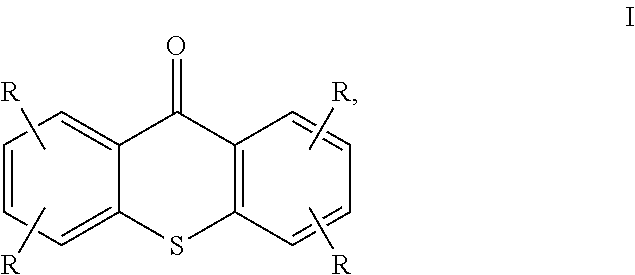Photoinitiator composition
a technology of photoinitiator and composition, which is applied in the field of photoinitiator composition, can solve the problems of not providing the details of any of the photoinitiator types necessary to cure such a composition, difficult surface cure, and small number of photoinitiators that absorb light in the region of led emission, etc., and achieves the effect of improving cure speed
- Summary
- Abstract
- Description
- Claims
- Application Information
AI Technical Summary
Benefits of technology
Problems solved by technology
Method used
Image
Examples
example 1
[0036]Black UV flexo ink formulations were prepared based on the following composition:
Materialwt %Black 7 pigment concentrate (SunChemical)35.0Blue 15:3 pigment concentrate (SunChemical)3.2Resistant violet 23 pigment concentrate (SunChemical)4.2Florstab UV1 stabilizer (Kromachem)1.5Radwax 65 wax dispersion (Kromachem)1.7Dynoadd F1 flow additive (Dynea)0.5Ebecryl 846 oligomer (Cytec)6.0Total52.1
[0037]Individual photoinitiator additives were included at levels as described below and the remainder of the formulation was made up to 100 parts using 22.9% of the acrylate monomer trimethylolpropane triacrylate (TMPTA, for example, SR351 from Sartomer) and 10% of the acrylate monomer hexane diol diacrylate (HDDA, for example, SR236 from Sartomer).
Maximum cureFormulationSensitizerPhotoinitiatorAmine synergistspeed (m / min)A18% Omnirad ITX12% Irgacure 36925% Omnirad EHA370(comparative)B18% Omnirad ITX2% Irgacure 3695% Omnipol ASA4>99C18% Omnirad ITX2% Irgacure 3695% Genopol AB15>99D18% Omnira...
example 2
Comparative
[0042]Black UV flexo ink formulations were prepared based on the composition as described in Example 1 except that the HDDA monomer was replaced by TMPTA. The photoinitiator composition was as described below. The performance of the formulations was tested as described in Example 1.
OmniradOmniradIrgacuremaximumFormulationEHAITX907cure speed(Comparative)(synergist)(senstizer)(initiator)(m / min)A25%10%0%40B25%8%2%60C25%6%4%40D25%4%6%40E25%2%8%30
[0043]These results demonstrate that the formulations containing a level of about 2% of aminoalkyl phenone photoinitiator such as Irgacure 907 (formulation B2) gives an increase in performance relative to a formulation that contains no aminoalkyl phenone (formulation A1). It can also be seen that higher levels of aminoalkyl phenone are not beneficial to the performance as these photoinitiators do not absorb light from the LED lamp but rely on a triplet energy transfer from the ITX which does absorb the LED light. At the highest level ...
example 3
[0044]Black UV flexo ink formulations were prepared based on the following composition:
Material%Black 7 pigment concentrate (SunChemical)35.0Blue 15:3 pigment concentrate (SunChemical)3.2Resistant violet 23 pigment concentrate (SunChemical)4.2Florstab UV1 stabilizer (Kromachem)1.5Radwax 65 wax dispersion (Kromachem)1.7Dynoadd F1 flow additive (Dynea)0.5Ebecryl 846 oligomer1 (Cytec)6.0Total52.11Ebecryl ™ 846 is modified tetra-functional acrylate polyester oligomer available from Cytec Surface Specialities Inc, Smyra, GA, USA.
[0045]The photoinitiator composition was as described below, with the formulation made up to 100 parts using the monomer TMPTA. The performance of the formulations was tested as described in Example 1.
OmniradIrgacureGenopolmaximumITX369AB1cure speedFormulation(senstiser)(initiator)(synergist)(m / min)A34.5%3%0%(comparative)B34.5%3%1%20C34.5%3%2%30D34.5%3%3%40E34.5%3%4%50F34.5%3%5%60
[0046]These results demonstrate that formulations containing an aminoalkyl phenone a...
PUM
| Property | Measurement | Unit |
|---|---|---|
| Fraction | aaaaa | aaaaa |
| Fraction | aaaaa | aaaaa |
| Fraction | aaaaa | aaaaa |
Abstract
Description
Claims
Application Information
 Login to View More
Login to View More - R&D
- Intellectual Property
- Life Sciences
- Materials
- Tech Scout
- Unparalleled Data Quality
- Higher Quality Content
- 60% Fewer Hallucinations
Browse by: Latest US Patents, China's latest patents, Technical Efficacy Thesaurus, Application Domain, Technology Topic, Popular Technical Reports.
© 2025 PatSnap. All rights reserved.Legal|Privacy policy|Modern Slavery Act Transparency Statement|Sitemap|About US| Contact US: help@patsnap.com

